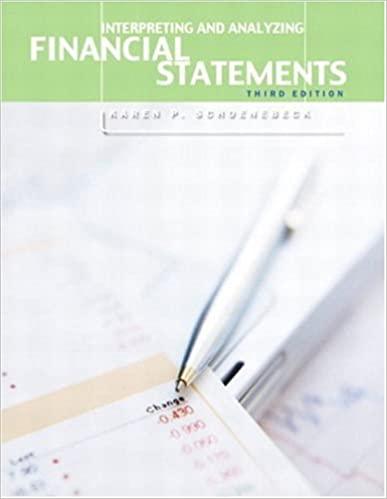Question
A noncurrent asset that is used in the normal operations of a business to generate revenue is called a fixed asset. The historical cost principle
A noncurrent asset that is used in the normal operations of a business to generate revenue is called a fixed asset. The historical cost principle is applied to fixed assets. A fixed asset should be recorded at its cost, which includes any expenditures necessary to prepare it for its intended use. The cost of a fixed asset, except for the cost of land, is allocated as an expense. When multiple assets are purchased as a group and each asset has a different estimated life, the cost of each asset must have a separate ledger account. In the case of a group purchase, the cost must be allocated among the assets acquired on the basis of each asset's proportion of the total fair market value of the assets acquired.
Fixed assets are reported in the________ section of the_________ . Fixed assets with different useful lives but purchased as a group must have_________ . Land has an indefinite life and is classified as_______ .
Assume that a building and the land it is situated on, along with a dump truck, are purchased at an auction. The three assets were purchased together for a price of $150,000. The fair market value of the assets are shown in the table below. Determine each asset's percentage of fair market value total. Then, apply that percentage to the group purchase cost to determine the allocated cost to be recorded for each asset.
Fair market value Percent of total Allocated cost
Land $54,375 % $
Building 130,500 % $
Truck 32,625 % $
Total __________ $ 100% $150,000
The Nature and Measurement of Depreciation
Depreciation is the process by which an asset's cost is allocated to expense over the asset's useful life and matched with the revenues that it helped earn. All fixed assets are depreciated with one exceptionland. Depreciation is recorded with a debit to Depreciation Expense (an expense) and a credit to Accumulated Depreciation (a contra-asset). The difference between the historical cost of the asset and its accumulated depreciation is known as the asset's book value. The acquisition cost must be accurately measured; the useful life and the salvage value must be estimated to calculate depreciation. The difference between the cost of the asset and the salvage value is known as the depreciable cost, the amount that will be expensed over the asset's life. By now, you should be able to complete the following statements.
1. Accumulated Depreciation is a ______ account.
2. Acquisition cost less accumulated depreciation is ______.
3. If the salvage value is zero, then accumulated depreciation at the end of the asset's useful life will be equal to the_____.
Declining Balance Depreciation
The declining balance method is an accelerated depreciation method. Depreciation is calculated by multiplying a constant depreciation rate by the book value. Because the book value decreases each period, so does the depreciationhence the name, the declining balance method. The first step is to calculate the declining balance depreciation rate. The concept is that the declining-balance rate is some multiple (m) of the straight-line rate. The formula is shown below.
Depreciation Rate = (m) x Straight-Line Rate
At the end of each period, the declining balance rate is applied to the current book value of the asset to determine the depreciation for the period. The depreciation is recorded with a debit to Depreciation Expense and a credit to Accumulated Depreciation. Note: The asset must be fully depreciated by the end of its useful life. The balance in Accumulated Depreciation should equaldepreciable cost, and book value should equal the residual value. Therefore, the final year's depreciation often needs to be calculated by comparing the accumulated depreciation to the depreciable cost. (See the example below.)
| 1. Determine the depreciation rate | ||||||||||||||||||||||||||||||||||||||||||||||||||||||||||
| 2. Calculate depreciation for year 1 | ||||||||||||||||||||||||||||||||||||||||||||||||||||||||||
| 3. Determine the book value for year 1 | ||||||||||||||||||||||||||||||||||||||||||||||||||||||||||
| 4. Calculate depreciation for year 2 | ||||||||||||||||||||||||||||||||||||||||||||||||||||||||||
| 5. Determine the book value for year 2 | ||||||||||||||||||||||||||||||||||||||||||||||||||||||||||
| 6. Calculate depreciation for year 3 | ||||||||||||||||||||||||||||||||||||||||||||||||||||||||||
| 7. Determine the book value for year 3 | ||||||||||||||||||||||||||||||||||||||||||||||||||||||||||
| 8. Calculate depreciation for year 4 | ||||||||||||||||||||||||||||||||||||||||||||||||||||||||||
| 9. Determine the book value for year 4 | ||||||||||||||||||||||||||||||||||||||||||||||||||||||||||
| 10. Calculate depreciation for year 5 | ||||||||||||||||||||||||||||||||||||||||||||||||||||||||||
| 11. Determine the book value for year 5 | ||||||||||||||||||||||||||||||||||||||||||||||||||||||||||
| 12. Consider these concepts APPLY THE CONCEPTS: Measure and record the purchase of a fixed asset On January 1, 2011, Kulatsu Engineering acquired a new piece of machinery and a used truck from Acme Equipment Company. Kulatsu negotiated a price of $156,250 for both items. The fair market value of the equipment was $144,000, and the fair market value of the truck was $36,000. Kulatsu Engineering signed a note with Acme to make the purchase. Prepare the journal entry to record the purchase of the equipment. Use Smart Entry when selection lists are not available to enter the account title in the Description column.
| ||||||||||||||||||||||||||||||||||||||||||||||||||||||||||
Step by Step Solution
There are 3 Steps involved in it
Step: 1

Get Instant Access to Expert-Tailored Solutions
See step-by-step solutions with expert insights and AI powered tools for academic success
Step: 2

Step: 3

Ace Your Homework with AI
Get the answers you need in no time with our AI-driven, step-by-step assistance
Get Started


